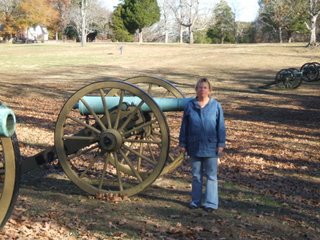

Well...seein' as how it was just such a delahtful day, we decided to stay in Pickwick, borrow the marina's courtesy cah and visit Shiloh Battlefield.
The battle took place April 6 & 7, 1862 with Union forces under U.S. Grant trying to cut the nearby railroad lines and Confederate forces under General Albert S. Johnston trying to prevent the rails from being taken. The National Park Service has done a good job of recording the event and making it accessible to the public. We took the driving tour, but to really see the site would take several days of walking. One very reasonable price gets you access to the site for 7 days.
Driving through the site I found it fascinating to see how much ground the troops had to cover during the 2 days of battle. And the terrain was quite varied from field to forest to swamp.
23,746 men were killed during the two days of fighting. The day after the battle, April 8 was exceptionally warm and General Grant ordered his men to bury all the dead in mass graves. Years later, all the Union soldiers were exhumed and reburied in individual graves, but the confederate troops remain to this day in the mass graves. What's wrong with this picture?
During the battle, General Johnston was shot in the leg and bled to death before medical care could reach him. He was, and remains, the highest ranking American officer to be killed in battle.
After the battle, Federal surgeons set up the first of what would later be called M.A.S.H. units. They gathered all the tents they could find and set up a field hospital. Prior to that time, the wounded would have had to be transported to either medical ships or fixed hospitals.
During one action, called the Hornet's Nest because of the sound of bullets buzzing past the ears of the men, the southern troops carried out the biggest field artillery barrage in history up to that point.
One of the officers who took part in this battle was Lew Wallace who would later gain fame as the author of "Ben Hur."
One other fascinating aspect of the tour was seeing how the army units on each side were organized. Prior to the War of Northern aggression (as it is still called down here) each State thought of itself as a free and independent nation. Thus, army units were organized by state, and this is reflected in the monuments scattered throughout the battlefield. For example, on the ground where troops from Iowa fought, the State of Iowa erected a monument. Likewise for each state, north and south, that sent troops to the battle. There was no "Union Army" or "Confederate Army." It was "The Army of Ohio" vs. "The Army of Mississippi."
On another note, as of yesterday we are officially on the Tenn-Tom Waterway. This waterway system is 450 miles long and stretches from Mobile Bay to the Tennessee River. A waterway here was first conceived by the early explorers, but wasn't completed until 1985. It was the largest public works project ever undertaken by the Army Corps of Engineers. In building the canal portion of the waterway, they had to move more earth than for the construction of the Panama Canal. This canal, called the Divide Cut, is over 25 miles long and we will be traveling through it tomorrow. It is 37 miles from here to the next marina, Bay Springs, on the other end of the Cut. There is no place to stop along the Cut, so we will have to make the trip in one day. After that, we will run the first of 12 locks that make up the system. The Whitten Lock is 85 feet high, one of the highest in the world.
Just think - 2 Billion of your tax dollars were spent just so Bev and I could make this trip. Thanks a Billion!



No comments:
Post a Comment